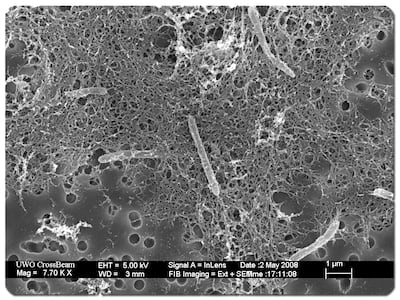For much of the past century, the search for life beyond Earth has followed a simple idea: find planets that resemble our own. These are worlds orbiting their stars at just the right distance to allow water to exist on the surface – the habitable zone.
However, it’s time to expand our thinking. Our solar system – and our galaxy – may contain many more potentially habitable environments than we once imagined. They just don’t look like Earth and they may not even see the Sun.
Our latest research, published in the International Journal of Astrobiology, proposes a new concept: the Radiolytic Habitable Zone. This refers to subsurface regions where water and cosmic radiation interact to produce energy that could sustain microbial life. Unlike the traditional habitable zone, which depends on sunlight and surface temperature, this new zone focuses on the hidden, underground potential of planets and moons.
The idea emerged from a remarkable discovery here on Earth. In a South African gold mine, 2.8 kilometres beneath the surface, scientists found a bacterium – Candidatus Desulforudis audaxviator – surviving in total darkness. It draws energy not from the Sun but from radiation in the surrounding rocks. Uranium, thorium and potassium break apart water molecules, releasing electrons, which the microbe uses as food. Life, it seems, had adapted to thrive where we least expected it.

That made us ask: could a similar process support life elsewhere in the solar system?
We focused on galactic cosmic rays – high-energy particles that stream through space. On Earth, we’re shielded by our atmosphere and magnetic field. But on planets like Mars, or icy moons such as Jupiter’s Europa and Saturn’s Enceladus, this radiation can penetrate the surface. If water or ice is present, the same kind of radiolysis could take place, releasing energy underground.
We built a numerical model and used our planetary simulation chamber at NYU Abu Dhabi to simulate this process. This helped us to understand how, when cosmic rays strike underground water, they break molecules apart in a process known as radiolysis, releasing electrons. Some Earth microbes already use such electrons to survive – much like plants use sunlight.
Our simulations showed that this could happen on other planets too. Among the bodies we studied, Enceladus had the greatest potential to support life in this way, followed by Mars, then Europa. The next step is to use our planetary simulation chamber at NYU Abu Dhabi for further experiments.
Water is still essential. Radiation alone is not enough. But where there is water below the surface – as is likely on these moons, and quite possibly on Mars – cosmic radiation could be part of the solution, not the problem.
This challenges how we approach space exploration. Most missions to Mars have focused on the surface. But if the most promising zones are one or two metres underground, we need to look deeper. The good news is that future missions are preparing to do just that.
The European Space Agency’s Rosalind Franklin rover, launching in 2028, is equipped with a drill that can reach two metres beneath the Martian surface. China’s Tianwen-3 mission will also collect and return subsurface samples. These missions could, within the next decade, offer our first real glimpse into Mars’ hidden biosphere.
As for Europa and Enceladus, missions so far have been limited to orbiters and flybys. These have provided stunning data – including evidence of organic molecules and plumes of water vapour. But no lander has yet explored them directly. At NYU Abu Dhabi, we’re now building a planetary simulation chamber to recreate these environments. This will help us better understand how microbial life might behave under such conditions – and guide the design of future instruments.
We're not stopping at theory. Our next step is to propose missions that target these zones directly, drilling beneath the surface where the conditions may be right for life.
That we are able to pursue this work in Abu Dhabi is no coincidence. After more than a decade in the US, I moved here because I found a research environment that values curiosity-led science. NYU Abu Dhabi gives our team the freedom to explore ambitious ideas – and the resources to test them. The UAE, more broadly, has made science and exploration a national priority.
The Emirates Mars Mission, which placed the Hope Probe in orbit around Mars in 2021, signalled the country’s arrival as a spacefaring nation. Now, the UAE is preparing an even more ambitious mission to the asteroid belt, launching in 2028 and running until 2035. I’m proud to be part of that science team. It will fly by six asteroids and attempt a landing on a seventh.
What makes the UAE’s approach effective is not just vision, but structure. The scientific community here is tightly connected. When we worked on the Emirates Lunar Mission, we built some of the instruments on campus with our own hands and worked closely with the national space agency just a short drive away. It’s an efficient model that encourages innovation – and gets things done.
Beyond the technical challenges, our research touches on some of the most fundamental questions we can ask: How common is life in the universe? How did it begin? And what would its discovery elsewhere say about our own origins?
We can now trace the universe all the way back to a tiny fraction of a second after the Big Bang. We can model the formation of galaxies, stars and planets with precision. But there’s still one thing we don’t understand: how life began. How did chemistry become biology? How did molecules start to replicate, evolve and eventually become sentient?
If we find microbial life in one of these extreme, hidden environments, we may be able to answer that question. Perhaps by studying how life survives in the dark, we’ll learn how it first emerged.
There’s a line from Jurassic Park that I often think about: “Life finds a way”. Every time we study extremophiles – microbes thriving in boiling acid, in Antarctica, or deep underground – we see that truth repeated. Life pushes beyond our limits.
And this research might also help us back on Earth. If microbes can harvest energy from radiation using highly efficient biochemical processes, we might one day mimic them. Bio-inspired batteries or novel electron-harvesting systems could transform how we generate clean energy.
That’s why the Radiolytic Habitable Zone deserves serious attention. It asks us to imagine life not in sunlight, but in the cold, silent dark. It reminds us that life doesn’t always look like us. And it tells us that to find it, we must be willing to dig deeper – literally and metaphorically.
This is science at its most powerful. Not just collecting data, but challenging assumptions. Not just exploring space but rethinking our place within it.


